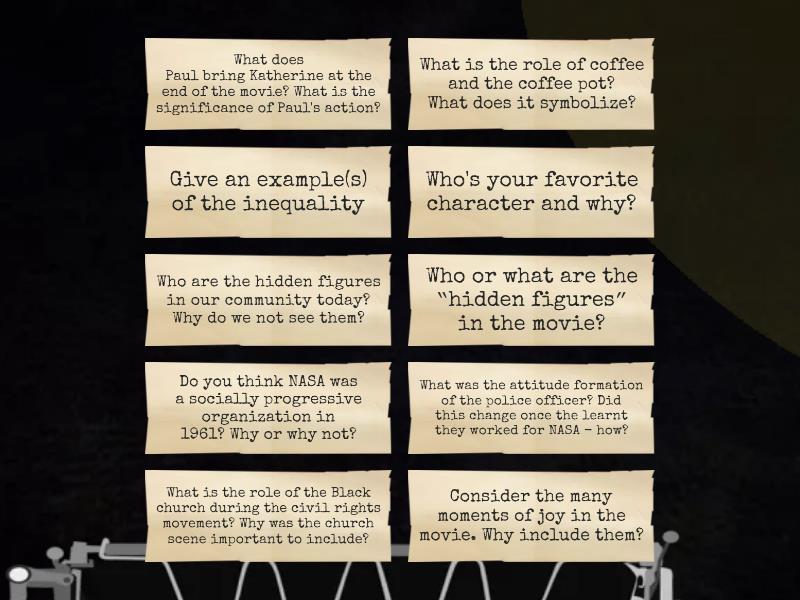In the realm of cinematic storytelling, few films manage to intersect the realms of historical significance, social justice, and emotional resonance quite like “Hidden Figures.” This film narrates the remarkable yet often overlooked contributions of three African-American women—Katherine Johnson, Dorothy Vaughan, and Mary Jackson—who were instrumental in NASA’s early space endeavors. The story they embody serves as a compelling microcosm of Bahá’í teachings, particularly regarding the principles of unity, equality, and the transformative power of knowledge. This discussion guide aims to facilitate dialogue among film groups by exploring the profound insights derived from the interplay of Bahá’í principles and the historical context depicted in the film.
Understanding the Background
Before delving into the film’s narrative, it is essential to contextualize the historical landscape of the 1960s America, which serves as the setting for “Hidden Figures.” During this epoch, segregation and systemic discrimination were rife, particularly in the realms of education and employment. The Bahá’í Faith emphatically promotes the concept of the oneness of humanity, underscoring that such societal injustices are antithetical to spiritual progress. Understanding this backdrop will enrich discussions about the characters’ struggles and triumphs, as it allows participants to appreciate how individual agency can emerge amid oppression.
The Principle of Equality
One of the most striking themes in “Hidden Figures” is the relentless pursuit of equality. As the protagonists navigate their professional realms, they confront not only racial barriers but also gender biases. Bahá’í teachings advocate for the equality of men and women as fundamental to societal advancement. Engage your discussion group by exploring critical moments in the film where the protagonists challenge the status quo. Questions could include: How do their actions resonate with the Bahá’í principle of equality? In what ways do these characters serve as exemplars of resilience against systemic biases?
Knowledge as a Catalyst for Change
Knowledge is celebrated within the Bahá’í Faith as a key driver for personal and communal development. The film showcases the intellectual prowess of the three women, illuminating how their contributions were not merely technical but also profoundly innovative. With this in mind, a poignant discussion topic could revolve around the role of education and expertise in effecting social change. What can we learn from the characters’ commitment to lifelong learning? How does the Bahá’í perspective on knowledge challenge traditional paradigms of education and intellectual achievement?
The Power of Collaboration
Collaboration emerges as a central tenet both in the film and within Bahá’í philosophy. The teamwork exhibited among the protagonists not only underscores the power of collective effort but also exemplifies the Bahá’í principle of consultation. In this context, initiate a dialogue about how collaborative dynamics can foster creativity and problem-solving. Analyze the methods they employed to overcome obstacles together. What strategies can contemporary communities learn from their camaraderie and unwavering support for one another?
Courage and Determination
The narrative of “Hidden Figures” is one steeped in remarkable courage and unyielding determination. Each protagonist embodies qualities that resonate deeply with the Bahá’í commitment to social justice and moral courage. Encourage film group members to reflect on how courage plays a pivotal role in both individual and collective endeavors. Discussions might cover: What sacrifices did the women face in pursuing their dreams? How can their experiences inspire us to confront injustices in our own lives?
Spiritual Perspectives on Challenges
In the face of substantial barriers, the Bahá’í teachings offer a perspective of viewing challenges as opportunities for spiritual growth. As participants engage with the film’s portrayal of adversity, prompt reflections on how struggle can lead to deeper understanding and compassion. Discuss: How did each character’s journey alter their perception of self-worth and capability? What parallels can be drawn between their experiences and the Bahá’í view of trials as pathways to spiritual elevation?
The Role of Faith
Faith, while not overtly highlighted in the film, serves as an implicit underpinning of the characters’ resolve. In the Bahá’í context, faith is not merely a personal adherence to religious beliefs but also encompasses trust in the potential for positive transformation. Facilitate discussions on how faith—as defined within the Bahá’í teachings—supports individuals in their quests against injustice. Consider questions such as: How does the practice of faith influence the characters’ decisions and actions in the film? Can a collective faith in humanity lead to substantial social progress?
Concluding Reflections
As your film group concludes its exploration of “Hidden Figures,” invite participants to reflect on the broader implications of the film in light of Bahá’í teachings. Encourage members to contemplate how the principles of equality, knowledge, collaboration, courage, and faith manifest not only within the narrative but also in their own lives. This dialogue serves as a reminder that the lessons derived from historical narratives continue to resonate today, urging us to embrace our shared humanity and work collectively towards a more equitable and just society.
